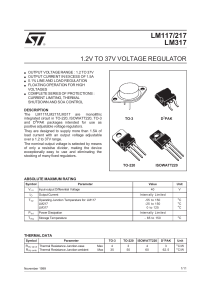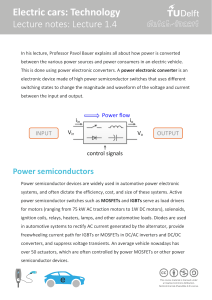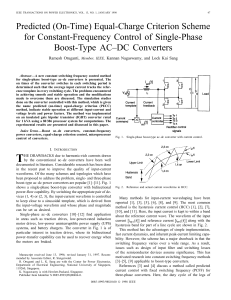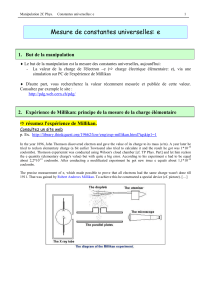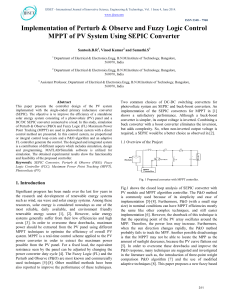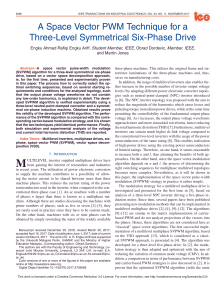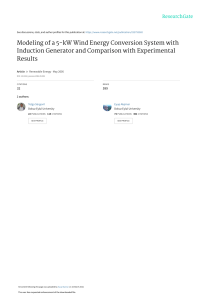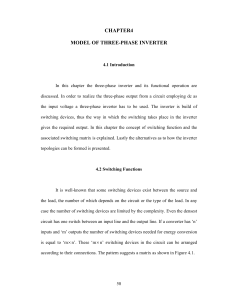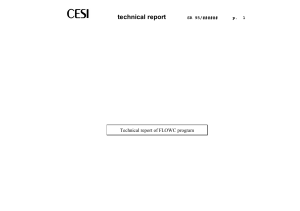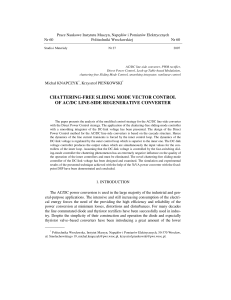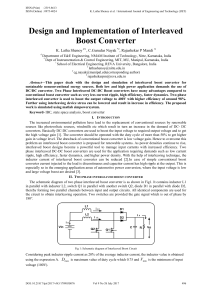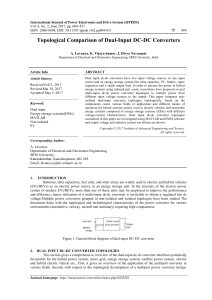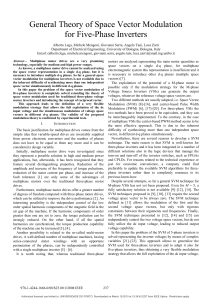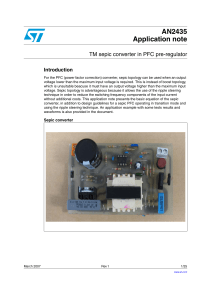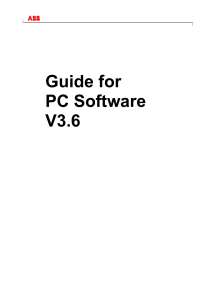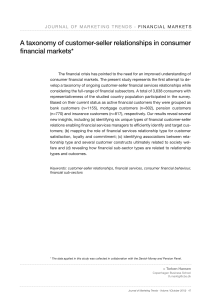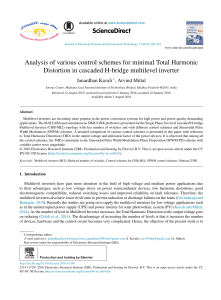Predictive Direct Power Control - A New Control Strategy for DCAC Converters
publicité
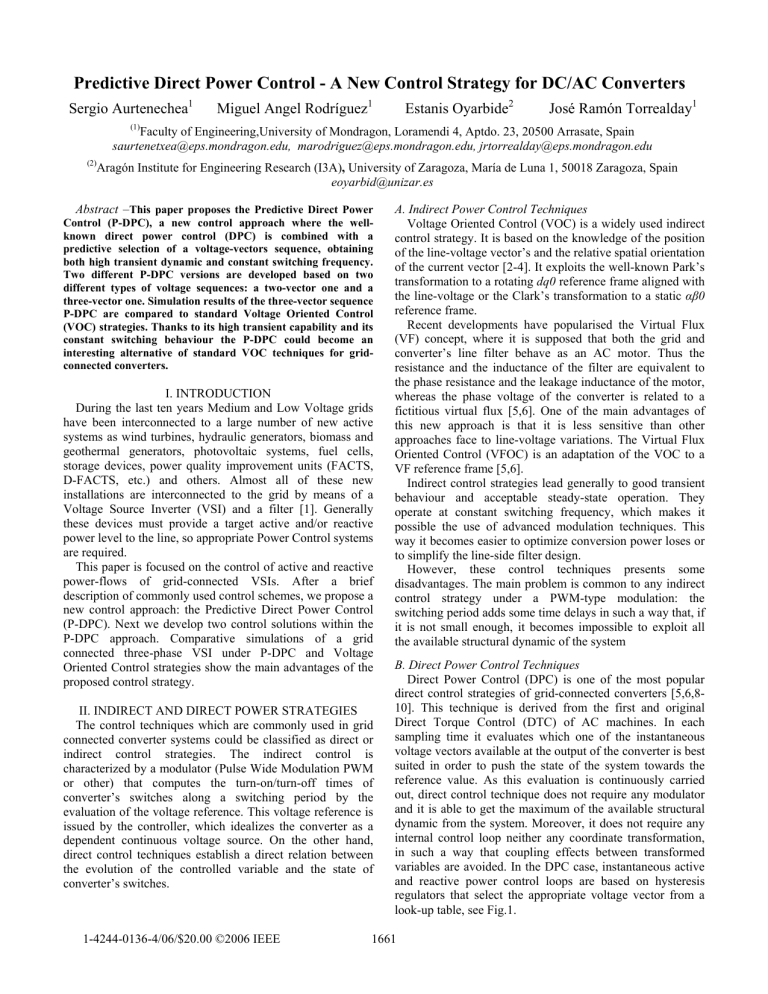
Predictive Direct Power Control - A New Control Strategy for DC/AC Converters Sergio Aurtenechea1 Miguel Angel Rodríguez1 Estanis Oyarbide2 José Ramón Torrealday1 (1) Faculty of Engineering,University of Mondragon, Loramendi 4, Aptdo. 23, 20500 Arrasate, Spain [email protected], [email protected], [email protected] (2) Aragón Institute for Engineering Research (I3A), University of Zaragoza, María de Luna 1, 50018 Zaragoza, Spain [email protected] Abstract –This paper proposes the Predictive Direct Power Control (P-DPC), a new control approach where the wellknown direct power control (DPC) is combined with a predictive selection of a voltage-vectors sequence, obtaining both high transient dynamic and constant switching frequency. Two different P-DPC versions are developed based on two different types of voltage sequences: a two-vector one and a three-vector one. Simulation results of the three-vector sequence P-DPC are compared to standard Voltage Oriented Control (VOC) strategies. Thanks to its high transient capability and its constant switching behaviour the P-DPC could become an interesting alternative of standard VOC techniques for gridconnected converters. I. INTRODUCTION During the last ten years Medium and Low Voltage grids have been interconnected to a large number of new active systems as wind turbines, hydraulic generators, biomass and geothermal generators, photovoltaic systems, fuel cells, storage devices, power quality improvement units (FACTS, D-FACTS, etc.) and others. Almost all of these new installations are interconnected to the grid by means of a Voltage Source Inverter (VSI) and a filter [1]. Generally these devices must provide a target active and/or reactive power level to the line, so appropriate Power Control systems are required. This paper is focused on the control of active and reactive power-flows of grid-connected VSIs. After a brief description of commonly used control schemes, we propose a new control approach: the Predictive Direct Power Control (P-DPC). Next we develop two control solutions within the P-DPC approach. Comparative simulations of a grid connected three-phase VSI under P-DPC and Voltage Oriented Control strategies show the main advantages of the proposed control strategy. II. INDIRECT AND DIRECT POWER STRATEGIES The control techniques which are commonly used in grid connected converter systems could be classified as direct or indirect control strategies. The indirect control is characterized by a modulator (Pulse Wide Modulation PWM or other) that computes the turn-on/turn-off times of converter’s switches along a switching period by the evaluation of the voltage reference. This voltage reference is issued by the controller, which idealizes the converter as a dependent continuous voltage source. On the other hand, direct control techniques establish a direct relation between the evolution of the controlled variable and the state of converter’s switches. 1-4244-0136-4/06/$20.00 '2006 IEEE A. Indirect Power Control Techniques Voltage Oriented Control (VOC) is a widely used indirect control strategy. It is based on the knowledge of the position of the line-voltage vector’s and the relative spatial orientation of the current vector [2-4]. It exploits the well-known Park’s transformation to a rotating dq0 reference frame aligned with the line-voltage or the Clark’s transformation to a static αβ0 reference frame. Recent developments have popularised the Virtual Flux (VF) concept, where it is supposed that both the grid and converter’s line filter behave as an AC motor. Thus the resistance and the inductance of the filter are equivalent to the phase resistance and the leakage inductance of the motor, whereas the phase voltage of the converter is related to a fictitious virtual flux [5,6]. One of the main advantages of this new approach is that it is less sensitive than other approaches face to line-voltage variations. The Virtual Flux Oriented Control (VFOC) is an adaptation of the VOC to a VF reference frame [5,6]. Indirect control strategies lead generally to good transient behaviour and acceptable steady-state operation. They operate at constant switching frequency, which makes it possible the use of advanced modulation techniques. This way it becomes easier to optimize conversion power loses or to simplify the line-side filter design. However, these control techniques presents some disadvantages. The main problem is common to any indirect control strategy under a PWM-type modulation: the switching period adds some time delays in such a way that, if it is not small enough, it becomes impossible to exploit all the available structural dynamic of the system B. Direct Power Control Techniques Direct Power Control (DPC) is one of the most popular direct control strategies of grid-connected converters [5,6,810]. This technique is derived from the first and original Direct Torque Control (DTC) of AC machines. In each sampling time it evaluates which one of the instantaneous voltage vectors available at the output of the converter is best suited in order to push the state of the system towards the reference value. As this evaluation is continuously carried out, direct control technique does not require any modulator and it is able to get the maximum of the available structural dynamic from the system. Moreover, it does not require any internal control loop neither any coordinate transformation, in such a way that coupling effects between transformed variables are avoided. In the DPC case, instantaneous active and reactive power control loops are based on hysteresis regulators that select the appropriate voltage vector from a look-up table, see Fig.1. 1661 The DPC technique has also been implanted under the VF concept, leading to the Virtual Flux Direct Power Control (VF-DPC) [5,6]. The main disadvantage of the DPC strategy is the resulting variable switching frequency, which generates an unwished harmonic range and makes it difficult to design the line-filter. In order to overcome this problem several approaches have been explored. The mixed DPC-SVM approach is an evolution of VFOC and VF-DPC techniques in such a way that it provides the required converter’s average voltage, which is applied by a Space Vector Modulation (SVM) [7]. This strategy could be defined as a direct control method based on the fact that converter’s average voltage vector is directly computed using active and reactive power tracking requirements. Nevertheless, in the frame of this paper and taking into consideration that it uses a modulator, it should be classified as an indirect control strategy. Predictive approaches have also been exploited in order to overcome the variable switching frequency problem of the DPC strategy. These solutions have been mainly employed in the control of AC machines [11-13]. Instead of selecting an instantaneous optimal voltage vector (DTC-case), predictive type approaches select an optimal set of concatenated voltage vectors, the so-called voltage vector’s sequence. The control problem is solved computing the application times of the vectors of the sequence in such a way that the controlled variables converge towards the reference values along a fixed predefined switching period. This way constant switching frequency operation is obtained. Several authors have developed this concept in multilevel converter topologies linked to different kind of machines but there are few predictive control cases on line-connected VSI systems. Some authors propose predictive current control algorithms related to power control requirements but this works present variable switching frequencies [14,15]. There is an interesting work related to line-current control where a sliding-control type approach is combined with a predictive computing of voltage application times [16]. This way both high transient dynamic and constant switching frequency are obtained. Based on this idea, it would be interesting to develop a new approach where direct power control is combined with predictive vector sequence selection, obtaining both high transient dynamic and constant switching frequency. DC/AC Converter VDC VDC_ref VDC Voltage Regulation Sa Sb L vka vkb vkc ika ikb ikc L L va vb vc A. Predictive Model of Instantaneous Power Evolution in a line-connected VSI The definition of instantaneous active or reactive power is still a source of controversy between the researchers. Among all the theories that have been successively proposed during the last years we retain the “original” three-wire system’s definition [17]. This way, instantaneous active and reactive powers are defined as follows (1): p vα q = v β dP = vα dt dQ = vβ dt Table θk Hysteresis Controllers p (1) dvα + vβ dt dv β − vα dt di β + iβ dv β dt dvα − iβ dt dt dt di β (2) di +v dt (3) Neglecting the influence of the resistances of inductive elements and using Clark’s transformation we get the instantaneous current evolution law under static coordinates (4). diα 1 ≅ (v Kα − vα ) dt L di β 1 ≅ (v Kβ − v β ) dt L (4) The line voltage variation is also required in (2). Considering a non-perturbed line: vα = V S sin (ωt ) (5) v β = −V S cos(ωt ) We get the next instantaneous line-voltage variation law: dvα = V S ω cos(ωt ) = −ω v β dt dv β = VS ω sin (ωt ) = ω vα dt (6) Replacing (4) and (6) in (2), the instantaneous active and reactive power evolution functions are obtained. P_ref Power Regulation diα + iα dt diα + iα dt vK = R i + L q Sector Select iα i β Equation (3) shows the per phase dynamic behaviour of a VSI with an inductive filter (Fig.2), with vK the converter’s voltage, v the line-voltage and i the line-current. Power Calculation / Estimation Look up vβ − vα With vα-β and iα-β the line voltage and current in static αβ coordinates. The prediction of the evolution of the power is based on the knowledge of the instantaneous variation of active and reactive powers, which can be expressed as: Sc Grid Voltage X III. PREDICTIVE DIRECT POWER CONTROL. THEORY AND APPLICATION TO A THREE-PHASE VSI The Predictive Direct Power Control (P-DPC) selects the best voltage-vector sequences and computes their application times in order to control the power flow through the VSI under a constant switching frequency operation. This strategy requires a predictive model of the instantaneous power evolution. Next, we show this predictive model and two possible control strategies. dP 1 = vα (vKα − vα ) + ω iβ + vβ dt L dQ 1 = vα ω iα − (vKβ − vβ ) + vβ dt L Q_ref Fig. 1. Block diagram of DPC 1662 1 (vKβ − vβ ) − ω iα L 1 (vKα − vα ) + ω iβ L (7) VSI vk VDC i 2) Application Times: Using equations (9) and constant switching frequency condition we can write the set of equations defining the overall evolution of active and reactive powers during the control period (10), see Fig. 3. Line R,L v DC/AC L Filter Fig. 2. One-phase model of a line-connected VSI Any given voltage ν k = [ν kα ν kβ ]T at the output of the VSI is kept constant during each voltage-vector application. In the same way, if the switching frequency is high enough, the line voltage ν = [ν α ν β ]T can be also considered as a constant value during the same period. Thus, and provided that current variations are small, we can consider that active and reactive power evolutions are kept at quasi-constant values during each voltage-vector application. These assumptions allow simple geometrical analysis of concatenated power evolutions. We can define active and reactive power-evolution slopes during a voltage vector application as: dP f pi = dt V =V (8) dQ f qi = dt V =V With i denoting the position index of the applied voltage in the sequence of voltage-vectors. This way we can compute the evolution of active and reactive powers under a given VSI voltage-vector application during the related application time. k i k i Pi = Pi −1 + f pi t ai Qi = Qi −1 + f qi t ai P1 = P0 + f p1 t a / Q1 = Q0 + f q1 ta P2 = P1 + f p 2 t0 / Q2 = Q1 + f q 2 t0 (10) Tsw = ta + t0 The control algorithm must compute the application time ta in such a way that controlled variables evolve from their initial values, {P0 Q0}, towards the reference values, {P2 Q2}. This problem has five equations and three variables, so an aproximative solution based on some optimization criteria must be computed. We can try to minimize the active and reactive power tracking errors, which are defined as: e po 647 4 8 e Fp = P_ ref − P0 − f p1 t a − f p 2 (TSW − t a ) (11) eqo 647 48 e Fq = Q _ ref − Q0 − f q1 t a − f q 2 (TSW − t a ) Using a least-square optimisation method we try to minimize the value of equation (12). 2 2 F = e Fp + e Fq (12) The optimal time of switching [ta] that minimizes the function F during a control period satisfies the minimum value condition: ∂F =0 ∂t a Solving this optimization application times are obtained. (9) With {Pi-1 Qi-1} initial active and reactive power values in the begining of the i-th vector of the sequence, tai the application time and {Pi Qi} the active and reactive power values at the end of the application time. B. P-DPC based on a two voltage vectors sequence This P-DPC version is based on the optimum concatenation of two (9)-type trajectories along the control period TSW. Fig. 3 shows an example containing a first steady state control period followed by a reference transient response. In the beginning of each period the control must select two of the applicable voltage vectors, followed by the computation of the required application times. 1) Switching Vector Selection: In this first approach we propose the use of an active voltage-vector followed by a null vector. It is desirable to reduce the number of commutations and with it the power losses of semiconductors. We can select the active vector by a look up table derived from any DPC strategy [5,8,9], whereas the null vector is chosen in such a way that only one switching action occurs in each TSW period. (13) problem P1(K+1) P the following f p2(K+1) fp1(K+1) fp1(K) P1(K) f p2(K) P_ref P2(K)=P0(K+1) P0(K) Q fq1(K) Q1(K) f q2(K) Q_ref Q2(K)=Q0(K+1) Q0(K) f q2(K+1) f q1(K+1) ta(K) tK t0(K) t0(K)=Tsw-ta(K) Q2(K+1) t0(K+1) ta(K+1) tK+1 T0(K+1)=Tsw-ta(K+1) Fig. 3. Example of the steady state and transient behaviour of PDPC based on a two vectors sequence 1663 ( ta = − ( f q 2 − f q 3 ) ⋅ e po + ( f p 3 − f p 2 ) ⋅ eqo + ( f q 3 ⋅ f p 2 − f q 2 ⋅ f p 3 ) ⋅ TSW t a1 = f q 3 ⋅ f p 2 − f q1 ⋅ f p 2 − f q 2 ⋅ f p 3 + f q1 ⋅ f p 3 − f q 3 ⋅ f p1 + f q 2 ⋅ f p1 ( f q 3 − f q1 ) ⋅ e po + ( f p1 − f p 3 ) ⋅ eqo + (− f q 3 ⋅ f p1 + f q1 ⋅ f p 3 ) ⋅ TSW ta 2 = f q 3 ⋅ f p 2 − f q1 ⋅ f p 2 − f q 2 ⋅ f p 3 + f q1 ⋅ f p 3 − f q 3 ⋅ f p1 + f q 2 ⋅ f p1 ) − TSW ⋅ f q 2 2 + f p 2 2 + TSW ⋅ ( f p 2 ⋅ f p1 + f q 2 ⋅ f q1 ) + e po ⋅ ( f p 2 − f p1 ) + e qo ⋅ ( f q 2 − f q1 ) (f − f p1 ) + ( f q 2 − f q1 ) 2 p2 2 (14) t 0 = TSW − t a C. P-DPC Based on a three voltage vectors sequence Fig.4 shows an example of the three-vector version of the P-DPC in a first steady-state control period followed by an reference transient. 1) Switching Vector Selection: The concatenation of three voltage-vectors offers an additional degree of freedom that can be used in order to reach complementary control objectives. In this work we try to minimize the switching losses following the idea of Minimum Loss Vector Pulse Wide Modulation (MLV-PWM) [18]. The voltage vector sequence is chosen in such a way that the switching of a VSI leg does not happen during the line-current maximum, leading to minimum switching losses (only two commutations per TSW period). The line-voltage plane is divided in six sectors of 60º, [θ1.. θ6], which are also divided in two subsectors, [θiA.. θiB], see Fig.5. As the use of the nearest voltage-vectors provides the smallest current riple, when the grid voltage is located at any given sector, θi, the voltage application sequence must be build by active voltage vectors belonging to the set {vri , vri −1 , vri +1 } and by one of the two nul vectors, {vr0 , vr7 } . In t a 3 = TSW − t a1 − t a 2 D. Proposed Control System Configuration The control block diagram of the proposed P-DPC technique is shown in Fig.6. Initial line voltage and current values are used in order to compute initial active and reactive powers [P0, Q0]. The proposed strategy evaluates this information and the target power values, selects the appropriate sequence and computes the application times which minimize the final tracking errors. the first sector case, for example, next two voltage application sequences are possible. r r r r r r θ 1 ⇒ { [v1 , v 6 , v 7 ], [v1 , v 2 , v 7 ] } (15) P1(K+1) P Q1 = Q0 + f q1 ⋅ t a1 P2 = P1 + f p 2 ⋅ t a 2 / Q2 = Q1 + f q 2 ⋅ t a 2 P3 = P2 + f p 3 ⋅ t a 3 / Q3 = Q2 + f q 3 ⋅ t a 3 fp1(K) P_ref P2(K) fp2(K) fp3(K) P0(K) fq2(K) Q fq1(K) Q1(K) Q_ref P3(K)=P0(K+1) Q2(K) fq3(K) Q3(K)=Q0(K+1) Q0(K) fq1(K+1) fq2(K+1) Q1(K+1) ta1(K) ta2(K) ta3(K) ta1(K+1) fq3(K+1) Q2(K+1) ta2(K+1) ta3(K+1) tK (16) tK+1 ta3(K)=Tsw-ta1(K)-ta1(K) ta3(K+1)=Tsw-ta1(K+1)-ta2(K+1) Fig. 4. Example of the steady state and transient behaviour of PDPC based on a three vectors sequence β Tsw = t a1 + t a 2 + t a 3 v3 (0,1,0) With {P0 Q0} the initial power values and {P3 Q3} the reference values. The new problem has seven equations and six variables, so an aproximative solution based on a similar optimization criteria of the previous case has been developed. This way, next aplication times are obtained: ∂F ∂t = 0 a1 ∂F = 0 ∂t a2 fp3(K+1) fp1(K+1) P1(K) 2) Application Times: The set of equations defining the overall evolution of active and reactive powers during the control period are: / P2(K+1) fp2(K+1) The apropriate sequence will depend on the implied subsector and the switching-losses optimization strategy, see [18]. P1 = P0 + f p1 ⋅ t a1 (18) v4 (0,1,1) θ3B θ4A θ4B θ5A θ3A θ2B θ2A θ1B v7 (1,1,1) θ1A v0 (0,0,0) θ6B θ5B θ6A v5 (0,0,1) (17) 1664 v2 (1,1,0) v1 (1,0,0) α v6 (1,0,1) Fig. 5. Relation between the voltage vectors of a three phase converter and the grid period division TABLE I SPECIFICATIONS OF THE GRID CONNECTED THREE PHASE VSI VOC with SV-PWM Value [unit] Sb Sc ika ikb ikc L P-DPC Strategy VDC_ref VDC Voltage Regulation fp1-2-3 fq1-2-3 abc αβ iα iβ Power Converter Predictive Vector Model Preselection P_ref Q_ref Po Qo 0.46 0.465 0.47 0.475 0.48 0.485 0.49 0.495 0.5 0.48 0.485 0.49 0.495 0.5 0.48 0.485 0.49 0.495 0.5 Phase 1 1 vb vc abc αβ 0.455 VOC with MLV-PWM Phase 1 L va 0.5 0 -0.5 -1 0.45 Direct Clark’s Transformation 0.455 0.46 0.465 0.47 0.475 P-DPC vα vβ 1 Phase 1 Sa Minimization Criteria L -1 0.45 Active & Reactive Power Calculation 0.5 0 -0.5 -1 0.45 Fig. 6. Block diagram of P-DPC 0.455 0.46 0.465 0.47 0.475 Time(s) Fig. 7. Phase switching signals along with the current and voltage IV. SIMULATION RESULTS In order to verify the behaviour of the proposed control algorithm comparative simulations involving VOC with SVPWM, MLV-PWM and three-vector type P-DPC strategies have been carried out. The specifications and parameters of the simulated model are listed in Table I. Fig. 7 shows the resulting per-phase switching signals and normalized perphase current and voltage (superposed). It can be observed that in MLV-PWM and P-DPC cases there are not switching actions along the maximum of the line-current. But improvement in power-losses is related to current-spectrum deterioration, see comparative in Fig. 8. The VOC-type SVPWM strategy shows the best power quality (THDi=2.78%), follower by the VOC-based MLV-PWM (THDi=3.38%) and finally, the P-DPC shows the worst current-quality (THDi=4.59%). It is an expected result as far as part of the degrees of freedom is not used in current control tasks. Nevertheless all strategies meet the IEEE Std 519-1992 recommendation. Detailed evolutions of variables under P-DPC are shown in Fig.9. Three control periods are represented. As it can be observed, quasi-linear active and reactive power trajectories evolve around the reference values, with a ripple of around 5%. But the best P-DPC results are obtained, as expected, in transient behaviour, see Fig. 10. Two steps of active and reactive power references from zero to 500kW and 218kVAr have been applied. Though the reactive power transients are similar in all the cases, the P-DPC is clearly faster in active power tracking task, as it takes only 3ms face to the 60ms required by any of the two VOC strategies. V. CONCLUSIONS A new predictive-type direct power control strategy (PDPC) is proposed. Thanks to this new approach constant switching frequency operation is obtained keeping the fast dynamic response related to direct control strategies. VOC with SV-PWM 0.04 Fundamental (50Hz) = 591.664 A THDi = 2.78% X= 50 Y= 1 0.03 X= 1900 Y = 0.014073 0.02 X= 3950 Y= 0.0061322 0.01 0 Mag (% of 50Hz Component) VDC vka vkb vkc 0 -0.5 0 1000 2000 3000 4000 X= 1900 Y= 0.013513 0.02 X= 3950 Y= 0.0072834 0.01 0 1000 2000 3000 4000 7000 8000 9000 10000 5000 9000 10000 9000 10000 X= 5900 Y= 0.0025241 6000 7000 8000 P-DPC 0.04 X= 50 Y= 1 0.03 0.02 Fundamental (50Hz) = 591.664 A THDi = 4.59% X= 1950 Y = 0.032323 X= 3950 Y= 0.0070852 0.01 0 6000 Fundamental (50Hz) = 591.664 A THDi = 3.38% X= 50 Y= 1 0.03 0 5000 X= 5900 Y= 0.00106 VOC with MLV-PWM 0.04 0 1000 2000 3000 X= 5950 Y= 0.0023607 4000 5000 6000 Frequency (Hz) 7000 8000 Fig. 8. Current frequency spectrum Switching Signals iDC Switching Signals Phase Current Phase Voltage 0.5 1 0.5 0 0.3 Phase 1 Phase 2 Phase 3 0.3005 0.301 0.3015 1.1 Active Power Power Reference 1.05 P [p.u] DC/AC Converter 1 500 [kVA] cosφ=0.9(i) 690 [V] 1.2 [mH] 20mF/1200 [V] 500 [µs] 1 0.95 0.9 0.3 0.3005 0.301 0.3015 0.301 0.3015 0.1 0.05 Q [p.u] Rated Power Rated line-to-line Voltage Filter (L) DC Link (CDC) Control Period TSW 0 -0.05 -0.1 0.3 Reactive Power Power Reference 0.3005 Time (s) Fig. 9. Power variations with respect to the switching signals 1665 VOC witth SV-PWM 1 0.8 0.8 Q [p.u] P [p.u] VOC witth SV-PWM 1 0.6 0.4 0.2 0.4 0.2 0 0 0.3 0.32 0.34 0.36 0.38 0.4 0.29 0.295 0.3 0.305 0.31 0.315 0.32 0.31 0.315 0.32 0.31 0.315 0.32 Time (s) Time (s) VOC witth MLV-PWM VOC witth MLV-PWM 1 Q [p.u] 1 P [p.u] 0.6 0.5 0 0.5 0 0.3 0.32 0.34 0.36 0.38 0.4 0.29 0.295 0.3 0.305 Time (s) Time (s) P-DPC P-DPC 1 1 Q [p.u] P [p.u] 0.8 0.6 0.4 0.2 0.5 0 0 0.29 0.295 0.3 0.305 Time (s) 0.31 0.315 0.32 0.29 0.295 0.3 0.305 Time (s) Fig. 10. Step response of active and reactive power The P-DPC presents a higher THD level than VOC strategies, but power-losses are reduced and fast transient dynamic behaviour is obtained. These results have been obtained with a first and simple P-DPC approach, so important improvements are possible. This is the case of active voltage-vector selection. The proposed strategy selects the nearest active voltage-vectors, in such a way that steadystate performance is improved. Obviously this is not the best strategy for transients, where other far active voltage-vectors would provide faster response. Another improvement could be based on monitoring the tracking error after each vector application, instead of waiting for the application of the overall sequence. This way, unpredicted deviations can be compensated and, moreover, this information could be exploited in an on-line parameter’s estimation system, leading to an adaptive P-DPC. As a general conclusion, the P-DPC approach could become an interesting alternative of VOC techniques for line-connected converters. VI. ACKNOWLEDGMENTS This work has been supported by the programs: Investigación Básica y Aplicada (PI 2003-11) and Formación de Investigadores del Dpto. de Educación, Universidades e Investigación from the Basque Government and by ENE2005-09218-C02-00 from MCYT DGI/FEDER. VII. REFERENCES [1] S. Bernet, "State of The Art and Developments of Medium Voltage Converters", in Proceedings of PELINCEC 2005, Warsaw, Poland. [2] R.Rocha and L.de Siqueira Martins, "A Discrete Current Control for PWM Rectifier", Proceedings of ISIE 2005, pp.681-686. [3] J.Lira, V.Cardenas, and C.Nunez, "Analysis and design of a PWM rectifier using the DQ theory and a digital control based in a DSP", Proceedings of CIEP 2004,pp. 52-57. [4] A.C.S.L.Guimarãres, F.A.S.Neves, M.A.Carvalho Jr, M.C.Cavalcanti, and Z.D.Lins, "Doubly Fed Induction Generators Active and Reactive Power Control," Proceedings of EPE-PEMC 2004. Riga, Latvia. [5] M. Malinowski, “Sensorless Control Strategies for Three - Phase PWM Rectifiers”, Thesis, Faculty of Electrical Engineering Institute of Control and Industrial Electronics, 2001,Warsaw, Poland. [6] Mariusz Malinowski, M.P.Kazmierkowski, and A.M.Trzynadlowski, "A Comparative Sutdy of Control Techniques for PWM Rectifiers in AC Adjustable Speed Drives," IEEE Trans. Power Electronics, vol 18, Nov. 2003, pp.1390-1396. [7] M. Malinowski and M.P.Kazmierkowski, "DSP Implementation of Direct Power Control with Constant Switching Frecuency for Three-Phase PWM Rectifiers," Proceedings of IECON 2002.pp.198-203. [8] G.Escobar, A.M.Stankovic´, J.M Carrasco, E.Galván, and R.Ortega, "Analysis and Design of Direct Power Control (DPC) for a Three Phase Synchronous Rectifier via Output Regulation Subspaces", IEEE Trans. Power Electronics, vol.18, May 2003, pp.823-830. [9] T.Noguchi, H.Tomiki, S.Kondo, and I.Takahashi, "Direct Power Control of PWM Converter Without Power-Source Voltage Sensors," IEEE Trans. Industry Applications, vol 34, May-June 1998, pp. 473-479. [10] S.Chen and G.Joós, "Direct Power Control Of Active Filters With Averaged Switching Frequency Regulation", Proceedings of PESC 2004, pp.1187-1194. [11] A.Linder and R.Kennel, "Direct Model Predictive Control—A new Direct Predictive Control Strategy for Electrical Drives", Proceedings of EPE 2005, Dresden, Germany. [12] A.BenAbdelghani, C.A.Martins, X.Roboam, and T.A.Meynard, "Use of Extra Degrees of Freedom in Multilevel Drives", IEEE Trans. Industrial Electronics, vol 49, Oct. 2002, pp.965-977. [13] M.Pacas and J. Weber, "Predictive Direct Torque for the PM Synchronous Machine", IEEE Trans. Industrial Electronics, vol 52, Oct. 2005, pp.1350-1356. [14] P.Antoniewicz, "Predictive Direct Power Control of a Rectifier," Proceedings of PELINCEC 2005, Warsaw, Poland. [15] J.Rodríguez, J.Pontt, P.Corea, U.Ammann, and P.Cortés, "Novel Control Strategy of an AC/DC/AC Converter Using Power Relations," Proceedings of PELINCEC 2005, Warsaw, Poland. [16] A.Sariñana, S.Guffon, G.Bornard and S.Bacha, "A Novel Fixed Switching Frequency Controller of a ThreePhase Voltage Source Inverter", Proceedings of EPE 1999, Lausanne, Switzerland. [17] H. Akagi, Y. Kanazawa, A. Nabae, “Instantaneous Reactive Power Compensators Comprising Switching Devices Without Energy storage Components”, IEEE Trans. Industry Applications, vol 20, May/June 1984, pp. 625-630. [18] A M Trzynadlowski and S Legowski,“ Minimum- Loss Vector Strategy for Three Phase Inverters”, IEEE Trans. Power Electronics, vol 9 Jan. 1994, pp 26-34. 1666


